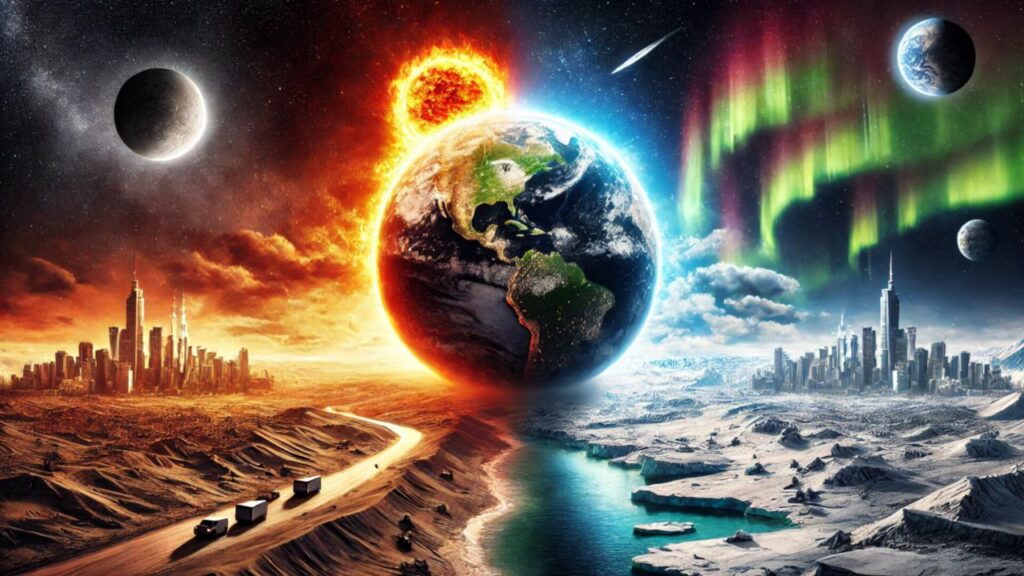If Earth were to suddenly stop rotating for an hour, the consequences would be catastrophic and far-reaching, affecting everything from the atmosphere to the oceans and life itself. Here’s a breakdown of what would happen and how life on the planet might cope:

1. Atmospheric Chaos
- Winds at Catastrophic Speeds: Earth’s atmosphere is moving with the planet’s rotation at speeds of up to 1,670 km/h (1,040 mph) at the equator. If Earth stopped spinning, the atmosphere would continue moving due to inertia, creating winds faster than the strongest hurricanes. These winds would devastate everything in their path, flattening structures, uprooting trees, and causing massive destruction.
- Pressure Changes: The sudden stop would create extreme pressure differences, leading to violent storms and unpredictable weather patterns.
2. Oceanic Disruption
- Tsunamis and Flooding: The oceans, like the atmosphere, are also moving with Earth’s rotation. A sudden stop would cause water to surge toward the poles and away from the equator, creating colossal tsunamis that would inundate coastal areas and reshape coastlines.
- Redistribution of Water: Over time, water would accumulate at the poles, leaving the equatorial regions dry and barren.
3. Geological Effects
- Earthquakes and Volcanic Activity: The abrupt halt would stress Earth’s crust, triggering massive earthquakes and potentially awakening dormant volcanoes. The tectonic plates, which are constantly moving, would experience immense strain, leading to widespread geological instability.
4. Temperature Extremes
- Day-Night Imbalance: Earth’s rotation creates a 24-hour day-night cycle. If it stopped, one side of the planet would face the Sun continuously, causing extreme heat, while the other side would plunge into freezing darkness. This would make most of the planet uninhabitable.
- Climate Collapse: The sudden temperature imbalance would disrupt global weather systems, leading to unpredictable and extreme climates. Also: What would happen if humans discovered a parallel universe?
5. Impact on Life
- Immediate Devastation: The combination of supersonic winds, tsunamis, earthquakes, and temperature extremes would cause widespread destruction, making survival nearly impossible for most life forms.
- Long-Term Consequences: If Earth resumed rotation after an hour, the planet would still be left in chaos. Ecosystems would be destroyed, agriculture would collapse, and human civilization would face an existential crisis.
How Would Life Cope?
- Human Survival: In the short term, people in underground shelters or heavily fortified structures might survive the initial chaos. However, long-term survival would depend on rebuilding infrastructure, managing extreme climates, and adapting to a drastically altered environment.
- Animal and Plant Life: Most species would not survive the immediate effects. Those that do would need to adapt quickly to the new environmental conditions, such as extreme temperatures and altered ecosystems.
- Technological Solutions: Advanced technology, such as climate-controlled habitats and artificial food production, might help humans and some species survive in the long term.
A sudden stop in Earth’s rotation, even for just an hour, would be a global catastrophe of unimaginable scale. The planet’s systems are intricately balanced, and disrupting one aspect—like rotation—would have cascading effects on everything else. While life might find a way to adapt over time, the immediate aftermath would be devastating for most living beings. Thankfully, this scenario is purely hypothetical and not something we need to worry about in reality!
More: “The Secret Behind Saturn’s Stunning Rings Will Blow Your Mind”
“How to Live on Mars: The Ultimate Guide to Surviving the Red Planet!”
Welcome to the Future: 10 Mind-Blowing Concepts That Will Shape Tomorrow’s Cities!
USA Announces Groundbreaking Plan to Build the World’s First Floating City by 2035

